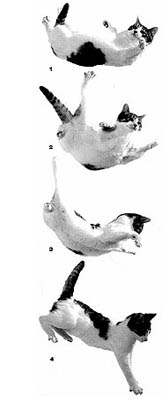
The mythicized ability of the cat to always fall on its feet is due to the combined action of the eyes and vestibular system (inner ear).
This action combined with the ability of the forelimbs and the vertebral column to make large movements (each vertebra is in fact connected to the next in a rather free way) means that the cat, even if falling from a 2 or 3 storey building, suffer marginal damage, precisely due to the fact that he always falls on his feet.
In the moment of the fall
When a cat falls, the eyes and vestibular apparatus inform the brain immediately.
Having noticed the position of the head relative to the ground, the muscles of the neck are activated by making it rotate, after which the rest of the body proceeds in rotation, while the tail acts as a stabilizing element.
The impact with the ground is cushioned by the limbs in order to protect the internal organs.